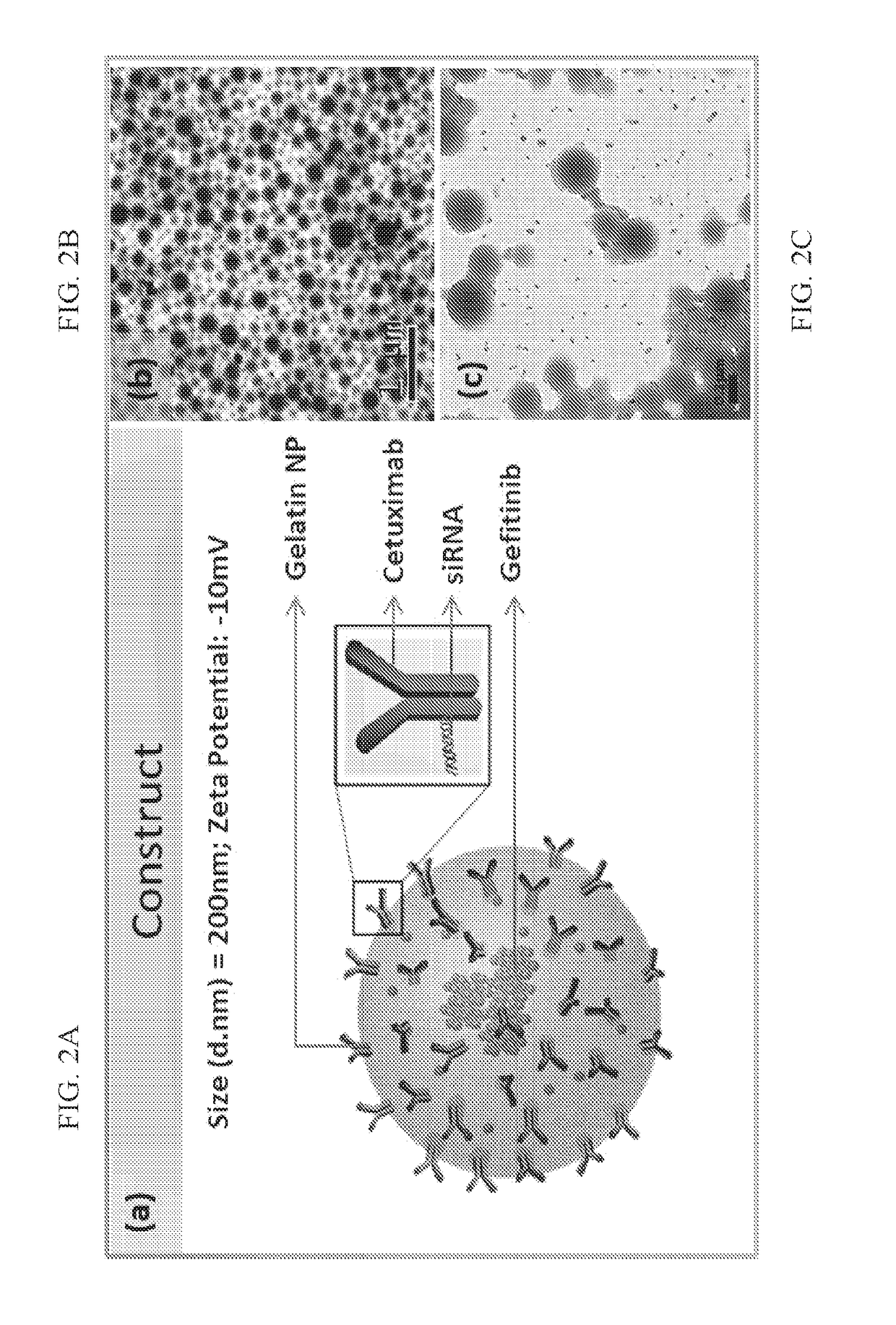Targeted nanoparticle conjugate and method for co-delivery of sirna and drug
a nanoparticle and conjugate technology, applied in the field of nanomaterials, can solve the problems of inability to target and deliver small interfering rna (sirna) to diseased sites, and inability to effectively deliver sirna to the cytoplasm of infected cells
- Summary
- Abstract
- Description
- Claims
- Application Information
AI Technical Summary
Benefits of technology
Problems solved by technology
Method used
Image
Examples
example 1
of nRAGeD Nanoconjugates
[0098]A two-step desolvation process was used to prepare gelatin nanoparticles. 500 mg of gelatin type A (bloom 300) was first dissolved in 10 ml of De-Ionized (DI) Water at 50° C. and subjected to first desolvation using rapid addition of acetone (20 ml). The precipitate was dissolved in 10 ml of DI water (pH2.75) and second desolvation using dropwise addition of acetone (3 ml / min) was initiated. Transformation of the transparent solution to a milky white solution indicated successful desolvation and formation of nanoparticles.
[0099]After 10 minutes, the nanoparticles were cross-linked with 200 μl of 25% glutardehyde. The reaction was allowed overnight at 50° C. and the resulting nanoparticulate solution was washed 5 times with DI water to remove excess glutaraldehyde (20,000 g for 45 minutes per wash).
[0100]For preparation of gefitinib encapsulation, 1 mg of gefitinib hydrochloride dissolved in DI water was added during the second desolvation process prior ...
example 2
ization of nRAGeD Nanoconjugates
[0107]Direct estimation of the amount of gefitinib encapsulated within the nanoparticles was carried out using absorption spectroscopy. 1 ml of the synthesized nanoparticles containing 1 mg / ml of gelatin nanoparticles was completely degraded using 2 mg / ml of protease. The degraded solution was centrifuged at 20,000 g for 30 minutes to ensure no precipitation of particles. The solution was then passed through 10 KDa Amicon filters (10000 g for 10 minutes) the filtrate was characterized for determining the Gefitinib content using absorption spectroscopy at 331 nm. The gefitinib standard curve was then used to determine the concentration of the analyzed filtrate.
[0108]Determination of the encapsulation efficiency of gefitinib within the nanoparticles and percent drug loading was characterized using UV-Vis spectroscopy as reported earlier for gefitinib and GelNPs. Gel(Gef)NPs at concentration of 2 mg / ml dispersed in DI water was subjected to protease degr...
example 3
of Cancer Cells with nRAGeD Nanoconjugates
[0118]To understand the cellular internalization capability, Gel NP encapsulated with fluorescein (fl) dye (GelflNP) and siRNA labeled with cy5 dye (siRNAcy5) were used for detection with two different fluorescent signals. The internalization study was performed in the KRAS mutant H23 non-small cell lung cancer cell line. The internalization was analyzed using fluorescence microscopy (FIG. 10).
[0119]The H23 cells were incubated with various analogues of the nanoconjugate. For simplicity, dyes, Fluorescein (fl) and Cy5 (cy5) functionalized to the corresponding ingredient of the nanoparticle is depicted through subscript. The various analogues are as follows: (1) GelflNP-Ab-siRNAcy5, (2) GelflNP-Ab-siRNA, (3) Gel NP-Abcy5-siRNA, (4) GelNP-Ab-siRNAcy5, (5) siRNAcy5 and (6) Abcy5. H23 cells were seeded in 6-well plates (5×105 cells / well). Cells were grown on a poly-L-lysine treated glass coverslip. 100 ul of each samples (Analogues 1, 2, 3, 4 an...
PUM
| Property | Measurement | Unit |
|---|---|---|
| hydrodynamic size | aaaaa | aaaaa |
| hydrodynamic diameter | aaaaa | aaaaa |
| concentration | aaaaa | aaaaa |
Abstract
Description
Claims
Application Information
 Login to View More
Login to View More - R&D
- Intellectual Property
- Life Sciences
- Materials
- Tech Scout
- Unparalleled Data Quality
- Higher Quality Content
- 60% Fewer Hallucinations
Browse by: Latest US Patents, China's latest patents, Technical Efficacy Thesaurus, Application Domain, Technology Topic, Popular Technical Reports.
© 2025 PatSnap. All rights reserved.Legal|Privacy policy|Modern Slavery Act Transparency Statement|Sitemap|About US| Contact US: help@patsnap.com



